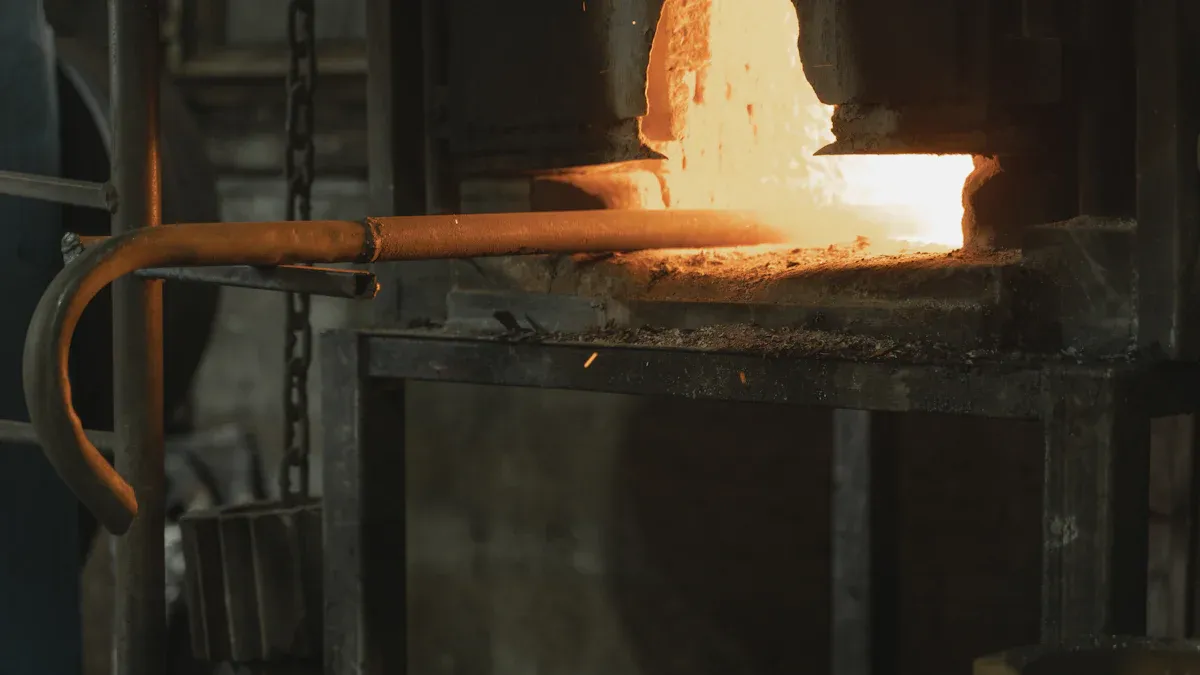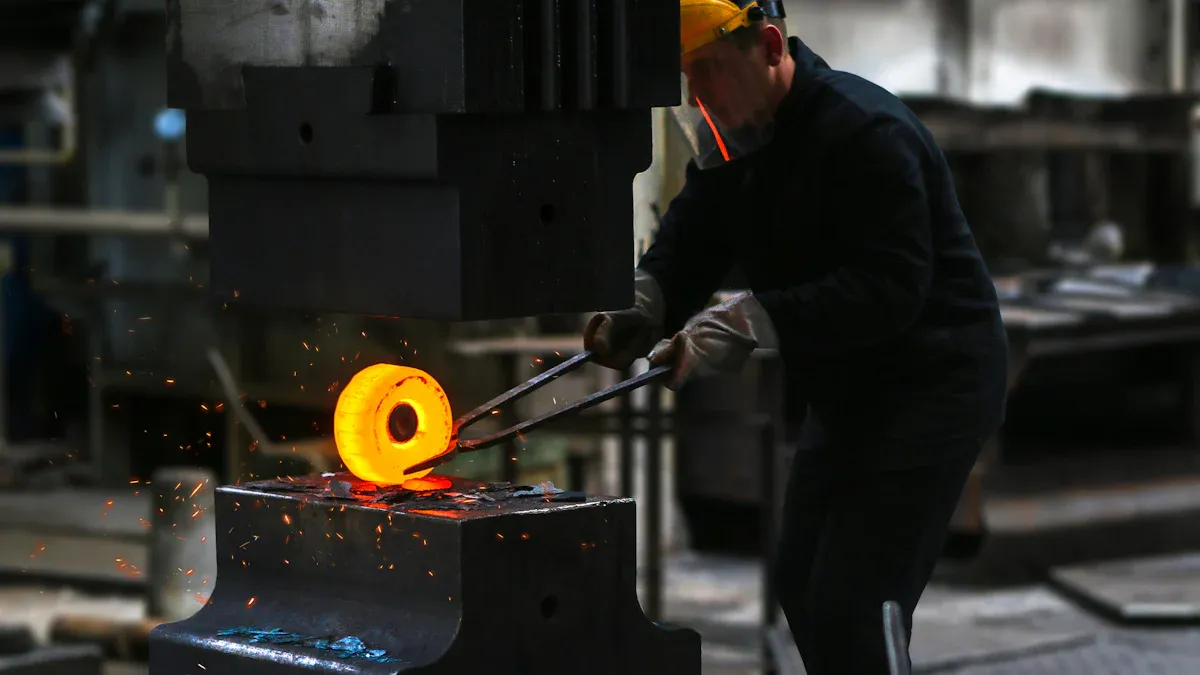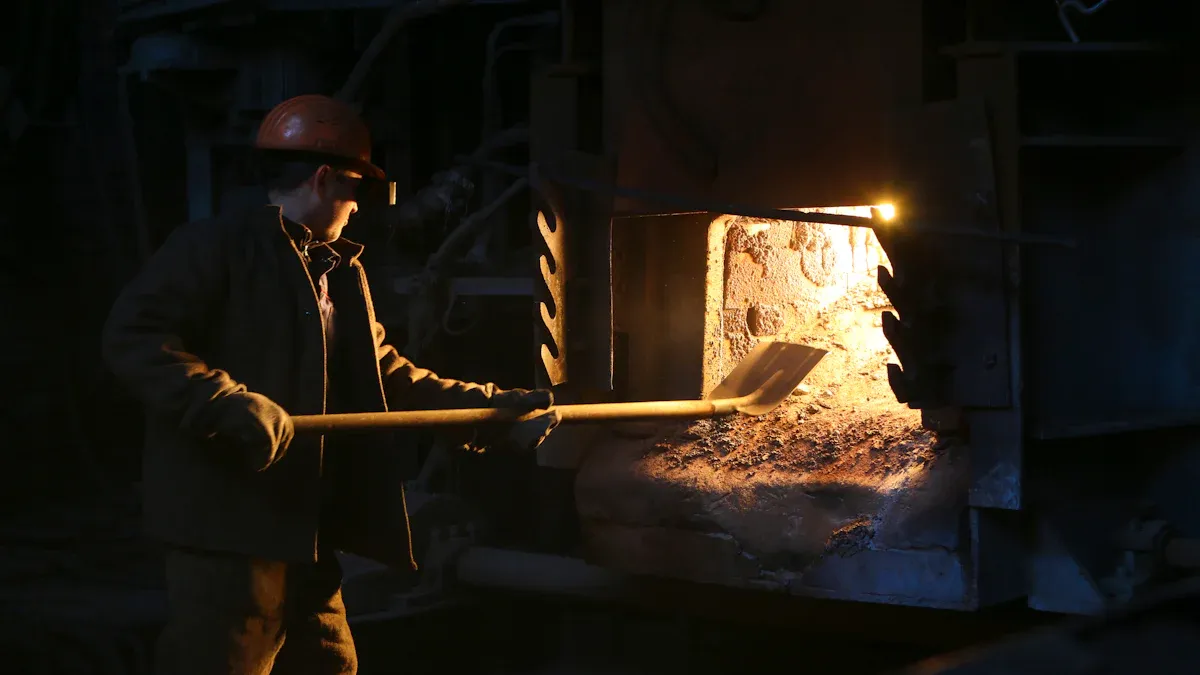
Choosing the right heating element impacts industrial efficiency and safety in 2025. The table below compares SiC Heating Element, MoSi2, and metal elements:
| Type | Max Temp (°C) | Lifespan |
|---|---|---|
| SiC Heating Element | 1600 | Medium |
| MoSi2 | 1800 | Long |
| Metal | 1200 | Short |
Tip: For high temperatures or harsh conditions, select the element that matches your specific process.
Key Takeaways
- SiC heating elements handle high temperatures up to 1600°C and resist corrosion, making them ideal for harsh industrial environments.
- MoSi2 elements reach even higher temperatures (up to 1800°C) and last the longest, offering great value for extreme heat applications.
- Metal heating elements cost less initially but have shorter lifespans and lower temperature limits, fitting moderate heat needs and quick replacements.
Types of Industrial Heating Elements

SiC Heating Element Overview
A SiC Heating Element uses silicon carbide as its core material. This type of element can reach high temperatures, making it suitable for demanding industrial processes. SiC Heating Element technology offers fast heating and cooling cycles. Operators often choose these elements for their ability to withstand harsh environments, such as those with corrosive gases or rapid temperature changes.
Note: SiC Heating Element units perform well in both oxidizing and reducing atmospheres, which increases their versatility in different industries.
MoSi2 Heating Elements Explained
MoSi2 heating elements use molybdenum disilicide as the main material. These elements can operate at even higher temperatures than SiC Heating Element options. MoSi2 elements resist oxidation at elevated temperatures, which extends their service life. Many industries use MoSi2 elements in high-temperature furnaces, especially when they need stable performance above 1600°C.
- MoSi2 elements offer:
- High maximum temperature
- Good resistance to chemical attack
- Long operational lifespan
Traditional Metal Heating Elements
Traditional metal heating elements use alloys such as nickel-chromium or iron-chromium-aluminum. These elements work well for moderate temperature applications. They are cost-effective and easy to replace. However, they have lower maximum temperature limits and shorter lifespans compared to SiC Heating Element and MoSi2 options. Metal elements often serve in ovens, dryers, and other equipment that does not require extreme heat.
SiC Heating Element vs MoSi2 vs Metal Elements: Key Comparisons

Temperature Range Comparison
Industrial heating elements must reach specific temperatures to support different processes. SiC Heating Element units can operate up to 1600°C. MoSi2 elements handle even higher temperatures, reaching up to 1800°C. Metal heating elements usually work best below 1200°C. Operators select MoSi2 for the highest temperature needs. SiC Heating Element options fit most high-temperature applications. Metal elements serve well in moderate heat environments.
Tip: Always match the heating element to the maximum temperature your process requires.
Lifespan and Durability
Durability affects how often a facility must replace heating elements. MoSi2 elements offer the longest lifespan. They resist wear and tear from repeated heating cycles. SiC Heating Element products provide a medium lifespan. They handle thermal shock better than metal elements. Metal heating elements have the shortest lifespan. They degrade faster under high temperatures and frequent use.
- MoSi2: Longest lifespan, less frequent replacement
- SiC Heating Element: Good durability, moderate replacement needs
- Metal: Short lifespan, frequent replacement
Oxidation and Corrosion Resistance
Industrial environments often expose heating elements to harsh chemicals and gases. MoSi2 elements resist oxidation at very high temperatures. SiC Heating Element units also perform well in both oxidizing and reducing atmospheres. Metal elements show the least resistance. They corrode faster, especially in aggressive environments.
Note: For processes with corrosive gases, SiC Heating Element and MoSi2 options provide better protection than metal elements.
Energy Efficiency and Performance
Energy efficiency impacts operating costs. MoSi2 and SiC Heating Element products heat up quickly and maintain stable temperatures. This reduces energy waste. Metal elements take longer to reach set temperatures. They lose more heat to the environment. Facilities that use SiC Heating Element or MoSi2 elements often see lower energy bills and more consistent performance.
Cost and Total Cost of Ownership
Initial purchase price matters, but so does the total cost over time. Metal heating elements cost the least upfront. However, their short lifespan and higher energy use increase long-term expenses. SiC Heating Element and MoSi2 products cost more at first. They last longer and use less energy, which lowers total ownership costs. MoSi2 elements, with their long lifespan, often provide the best value for high-temperature applications.
| Element Type | Initial Cost | Replacement Frequency | Energy Use | Total Cost Over Time |
|---|---|---|---|---|
| Metal | Low | High | High | High |
| SiC Heating Element | Medium | Medium | Low | Medium |
| MoSi2 | High | Low | Low | Low |
Typical Industrial Applications
Each heating element type fits specific industrial needs.
- SiC Heating Element: Used in ceramics, glass, and metallurgy industries. Handles processes with rapid temperature changes and harsh atmospheres.
- MoSi2: Chosen for high-temperature furnaces, laboratory kilns, and specialty glass production.
- Metal: Common in ovens, dryers, and equipment that does not require extreme heat.
Operators should review their process requirements before selecting a heating element.
Selecting the Right Heating Element for Your Application
Matching Temperature Requirements
Every industrial process has a specific temperature range. Operators must select heating elements that can reach and maintain the required heat. MoSi2 elements work best for applications above 1600°C. Metal elements suit processes below 1200°C. SiC Heating Element options fill the gap for most high-temperature needs. Always check the maximum temperature rating before making a choice.
Considering Atmosphere and Environmental Factors
Industrial environments can expose heating elements to gases, moisture, or dust. MoSi2 elements resist oxidation in high-heat settings. Metal elements may corrode quickly in harsh atmospheres. SiC Heating Element units perform well in both oxidizing and reducing environments. Operators should review the process atmosphere to avoid early failure.
Budget and Cost Considerations
Initial cost matters, but so does long-term value. Metal elements cost less upfront but need frequent replacement. MoSi2 and SiC Heating Element products have higher purchase prices. Their longer lifespan and energy savings often lower total costs over time.
Tip: Calculate both initial and ongoing expenses to find the best value for your operation.
Maintenance and Replacement Needs
Some heating elements require more frequent checks and replacements. Metal elements need the most attention. MoSi2 elements last longer and need less maintenance. SiC Heating Element products offer moderate maintenance needs. Operators should plan for downtime and labor costs.
Storage and Handling Requirements
Proper storage extends the life of heating elements. Metal elements need dry, clean storage to prevent rust. MoSi2 and SiC Heating Element units require careful handling to avoid breakage. Always follow manufacturer guidelines for storage and transport.
Addressing Common Concerns with SiC Heating Element and Alternatives
Replacement Feasibility
Operators often ask how easy it is to replace heating elements. SiC Heating Element units offer straightforward replacement in most industrial systems. MoSi2 elements require careful handling because of their brittleness. Metal elements are the easiest to swap out, making them popular for quick repairs. Facilities should always follow manufacturer guidelines during replacement to avoid damage.
Expected Lifespan
The expected lifespan of a heating element depends on the type and the operating environment. MoSi2 elements last the longest, often several years in stable conditions. SiC Heating Element products provide a medium lifespan, usually between metal and MoSi2 options. Metal elements wear out the fastest, especially at high temperatures or with frequent cycling.
Note: Regular monitoring helps extend the life of any heating element.
Maintenance Demands
Maintenance needs vary by element type. Metal elements require frequent checks for corrosion or breakage. SiC Heating Element units need moderate maintenance, mainly to inspect for cracks or surface wear. MoSi2 elements demand less frequent attention but must be checked for oxidation at connection points.
Storage and Shelf Life
Proper storage ensures heating elements remain effective. Metal elements need dry, rust-free storage. SiC Heating Element and MoSi2 products should be stored in padded containers to prevent chipping or breakage. Most heating elements have a long shelf life if stored correctly.
SiC heating elements suit high-temperature, corrosive environments. MoSi2 elements work best for extreme heat. Metal elements fit low-cost, moderate applications.
Steps for 2025:
- Identify process temperature.
- Check atmosphere needs.
- Review budget.
Decision-makers should consult suppliers for tailored solutions.
FAQ
What is the main advantage of SiC heating elements?
SiC heating elements handle high temperatures and resist corrosion. They work well in harsh industrial environments. Many industries choose them for reliability and performance.
How often should operators inspect heating elements?
Operators should inspect heating elements monthly. Regular checks help prevent unexpected failures. Early detection of wear or damage extends the element’s lifespan.
Can metal heating elements be used in corrosive atmospheres?
Metal heating elements do not perform well in corrosive atmospheres. They corrode quickly and fail faster. SiC or MoSi2 elements offer better resistance in these conditions.


